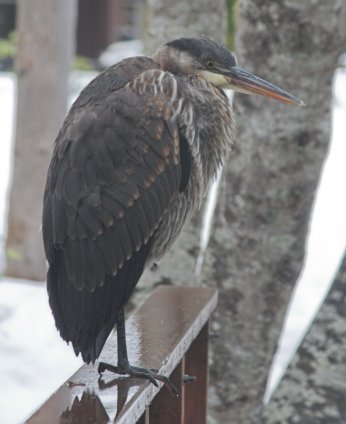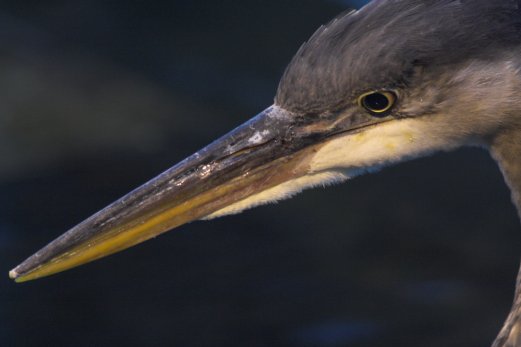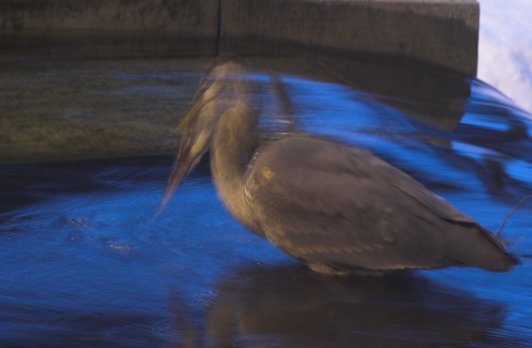
Great Blue Herons are relatively common in Sitka, though they do not occur in large numbers. It’s usually easy to find one somewhere along the shore at low tide where the fishing is good. When the tide is up, they can be a little more difficult to spot roosting in the trees. They seem to keep to themselves, for the most part, though occasionally I have seen several of them together. There have been 3 or 4 down in the tidepools at Totem Park, and one day I saw 7 of them fly over the campus.
Last winter there was a Great Blue Heron that frequented the waterway running through the campus. Several folks really enjoyed seeing the bird and thought it would be a good idea to name it. Ardy was chosen because it fit with the bird’s scientific name (Ardea herodius) and seemed acceptably androgynous (folks were uncertain whether the bird was a male or female). It was seen frequently by people walking by, either up near the falls or down along the creek between the falls and the woods. Sometime in the spring or early summer, it seems to have left, though. I guess I’m not postive about that, but I do not remember seeing it in the summer, in any case.
This year there has been a heron back at the flume. I do not know for sure whether it is the same bird, but people on campus who were here last year and remember that bird have taken to calling this one Ardy as well. I had heard about it for at least a couple of weeks befor I saw it for the first time yesterday. This year’s heron does not have the white crown characteristic of an adult, so it is still a young bird. What photos I got of last years bird look pretty similar, so if it is the same bird, it still has not attained its adult plumage. The Birds of North America entry on Great Blue Herons indicates that the birds take almost two years to attain their adult plumage, so it seems possible that this bird is the same one as last year. However, that would imply last year’s bird was just hatched that summer.

This year, the bird seems far more tolerant of passers-by than the one last year. Perhaps, if this is the same bird as last year, it finally figured out that the people walking by were not a threat, and decided it was not worth the effort to go someplace else. The portrait of the heron that is shown above is uncropped. I was less than 10 feet away from the bird as it was fishing at the top of the flume falls.
I think this bird likes the flume because of the lights. There is a bridge that crosses the flume just above the falls and this bridge has two lights that shine on it. The light seems to be enough for the heron to see the small fish swimming in the water. When I first observed the bird Sunday morning, it was barely getting light and the heron was fishing. A student who had been working the night before told me the bird was there between 8pm and Midnight. My guess is the heron spent the night. It may not have spent the whole time fishing, but with these short winter days, I’m guessing this location is the heron equivalent of a 24 hour convenience store.

The light was still quite dim when I took this photo (1/2 second exposure). Much of the light was coming from two very yellow (sodium vapor?) lights. I was able to compensate for this, but the result is the unnaturally blue light reflected in the water. The reflections were from the more neutral colored overcast sky.
Although I do not think the heron was actually going for a fish when this last picture was taken, you can get some idea of the motion it makes to catch a fish. The heron will stand still with its head in the upper position watching and waiting for a fish to swim close enough. When a fish comes close, the heron will quickly strike its bill down into the water to grab the fish. While I was watching the heron made several strikes and caught at least two fish. The fish it caught were small enough for it to just grab them with its beak. However, I have also seen a heron with a larger fish that it actually speared.
It will be interesting to see if this heron hangs around for the whole winter. I am not sure what their nutritional needs are, but I would wonder if there are enough small fish in the flume to keep a heron well-fed for several weeks. Perhaps this bird also goes down to the beach for additional food. It would be interesting to know.
1 thought on “Great Blue Heron”